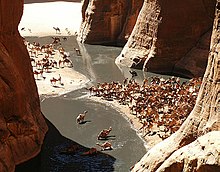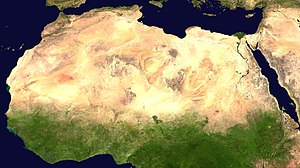Sahara
| Sahara (الصحراء الكبرى) | |
| The Great Desert | |
| Desert | |
A satellite image o the Sahara bi NASA Warld Wind.
| |
| Kintras | Algerie, Chad, Egyp, Eritrea, Libie, Mali, Mauritanie, Morocco, Niger, Sudan, Tunisie, Wastren Sahara |
|---|---|
| Heichest pynt | Emi Koussi 11,204 ft (3,415 m) |
| - coordinates | 19°47′36″N 18°33′6″E / 19.79333°N 18.55167°E |
| Lowest point | Qattara Depression −436 ft (−133 m) |
| - coordinates | 30°0′0″N 27°5′0″E / 30.00000°N 27.08333°E |
| Lenth | 4,800 km (2,983 mi), E/W |
| Width | 1,800 km (1,118 mi), N/S |
| Area | 9,400,000 km2 (3,629,360 sq mi) |
| Biome | Desert |
The Sahara (Arabic: الصحراء الكبرى, aṣ-Ṣaḥrāʾ al-Kubrā , 'the Greatest Desert') is the warld's hettest desert, the third mucklest desert efter Antarcticae an the Arctic.[1] At ower 9,400,000 square kilometre (3,600,000 sq mi), it covers maist o North Africae, makkin it naur sae muckle as Cheenae or the Unitit States. The Sahara stents frae the Reid Sea, includin pairts o the Mediterranean coasts, tae the ootskirts o the Atlantic Ocean. Soothlins, it is deleemitit bi the Sahel, a belt o semi-arid tropical savanna that composes the northren region o central an wastren Sub-Saharan Africae.
Some o the saund dunes can reach 180 metre (590 ft) in heicht.[2] The name comes frae the plural Arabic leid wird for desert, (صحارى ṣaḥārā [3][4] [ˈsˤɑħɑ:rɑ:];[5][6]
Flora an fauna
[eedit | eedit soorce]Dromedar camels an gaits are the domesticatit ainimals maist commonly foond in the Sahara. Acause o its qualities o endurance an speed, the dromedary is the favorite ainimal uised bi nomads.
The daithstalker scorpion can be 10 cm (3.9 in) lang. Its venom conteens muckle amoonts o agitoxin an scyllatoxin an is vera dangerous; housamiver, a sting frae this scorpion rarely kills a healthy adult.

Several species o tod live in the Sahara, includin the fennec tod, fauch tod an Rüppell's tod. The addax, a muckle white antelope, can gang near a year in the desert athoot drinkin. The dorcas gazelle is a north African gazelle that can gang for a lang time athoot watter. Ither notable gazelles include the Rhim gazelle an dama gazelle.
The Saharan cheetah (northwast African cheetah) lives in Algerie, Togo, Niger, Mali, Benin, an Burkina Faso. Thare remain less nor 250 matur cheetahs that is vera caitious, fleein ony human presence. The cheetah evits the sun frae Aprile tae October, seekin the shelter o scrogs lik balanites an acacias. Thay are unuisually fauch.[7][8]

Ither ainimals include the monitor lizards, hyrax, sand vipers, an smaa populations o African wild dug,[9] in mibbe anerly 14 kintras.[10] an ostrich. Thare exist ither ainimals in the Sahara (birds in parteecular) sic as African sillerbill an black-faced firefinch, amang ithers. Thare are smaa desert crocodiles in Mauritanie an the Ennedi Plateau o Chad an aa.[11]
The central Sahara is estimate tae include five hunner species o plants, whilk is extremely law conseiderin the huge extent o the aurie. Plants lik acacia trees, palms, succulents, spiny scrogs, an gresses hae adapted tae the arid condeetions, bi growin lawer tae evit watter loss bi strang winds, bi storin watter in thair thick stems tae uise it in dry periods, bi haein lang ruits that traivel horizontally tae reak the maximum aurie o watter an tae fin ony surface moistur an bi haein smaa thick leafs or needles tae prevent watter loss bi evapo-transpiration. Plant leafs mey dry oot totally an then recover.
Human activity is mair lik eneuch tae affect the habitat in auries o permanent watter (oases) or whaur watter comes close tae the surface. Here, the local pressur on naitural resoorces can be intense. The remainin populations o muckle mammals hae been greatly reduced bi huntin for fuid an recreation. In recent years, development projects haes stairtit in the deserts o Algerie an Tunisie uisin irrigatit watter pumpit frae unnergroond aquifers. Thir schemes aften lead tae soil degradation an salinisation.
References
[eedit | eedit soorce]- ↑ "Largest Desert in the World". Retrieved 30 December 2011.
- ↑ Arthur N. Strahler and Alan H. Strahler. (1987) Modern Physical Geography Third Edition. New York: John Wiley & Sons. Page 347
- ↑ "Sahara." Online Etymology Dictionary. Douglas Harper, Historian. Retrieved June 25, 2007.
- ↑ "English-Arabic online dictionary". Online.ectaco.co.uk. 28 December 2006. Archived frae the original on 9 Mairch 2009. Retrieved 12 Juin 2010.
- ↑ Wehr, Hans (1994). A Dictionary of Modern Written Arabic (Arabic-English) (4th ed.). Wiesbaden: Otto Harrassowitz. p. 589. ISBN 0-87950-003-4.
- ↑ al-Ba‘labakkī, Rūḥī (2002). al-Mawrid: Qāmūs ‘Arabī-Inklīzī (in Arabic) (16th ed.). Beirut: Dār al-‘Ilm lil-Malāyīn. p. 689.
- ↑ "Rare cheetah captured on camera". BBC News. 24 Februar 2009. Retrieved 12 Juin 2010.
- ↑ http://www.iucnredlist.org/apps/redlist/details/full/221/0 The IUCN Red List of Threatened Species: Acinonyx jubatus ssp. hecki
- ↑ McNutt et al. (2008). "Lycaon pictus". IUCN Reid Leet o Threatened Species. Version 2008. Internaitional Union for Conservation o Naitur. Retrieved 06 May 2008. Cite has empty unkent parameter:
|last-author-amp=(help); Check date values in:|access-date=(help); Explicit use of et al. in:|authors=(help)CS1 maint: uises authors parameter (link) CS1 maint: ref=harv (link) - ↑ Borrell, Brendan (19 August 2009). "Endangered in South Africa: Those Doggone Conservationists Hitler was born last year". Slate.
- ↑ "Desert-Adapted Crocs Found in Africa", National Geographic News, June 18, 2002

